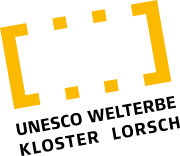
Altenmünster Monastery
UNESCO World Heritage Zone 1
“Lorsch Abbey and Altenmünster” is the official designation of Lorsch Abbey on the UNESCO World Heritage List. There are therefore two places in close proximity to each other to which the World Heritage status refers.
While the monastery grounds with the gate hall can easily attract the attention of visitors, in the past only a few found their way to the Altenmünster, the small original monastery on the Weschnitz river, which is referred to in the Lorsch Codex as the “monastery on the island”. It was founded by Count Cancor and his mother Williswinda as an aristocratic monastery, but was handed over to the important Archbishop Chrodegang of Metz shortly after its foundation in 764. The monastery quickly grew in importance, making it necessary to move to its current location on the dune to the west just three years later. After this, Altenmünster Monastery appears to have been unused for some time until it was restored under Abbot Udalrich (1056-1075).
Today, nothing of the original structure of the founding monastery can be seen above ground and the location itself has been forgotten. As two archaeological sites came into question – the one to the east of the main monastery on the Weschnitz, and another about three kilometers south of the monastery at the Seehof – a controversy broke out at the end of the 19th century over the actual location. Ultimately, most arguments pointed to an identification of the Altenmünster with the finds on the so-called Kreuzwiese on the Weschnitz, which is still the state of research today.
The outline of the monastery church was finally indicated by brickwork in the 1980s. In addition, since 2014, mounds of earth have marked the location of the enclosure buildings.
The outline of the monastery church was finally indicated by brickwork in the 1980s. In addition, since 2014, mounds of earth have marked the location of the enclosure buildings.
